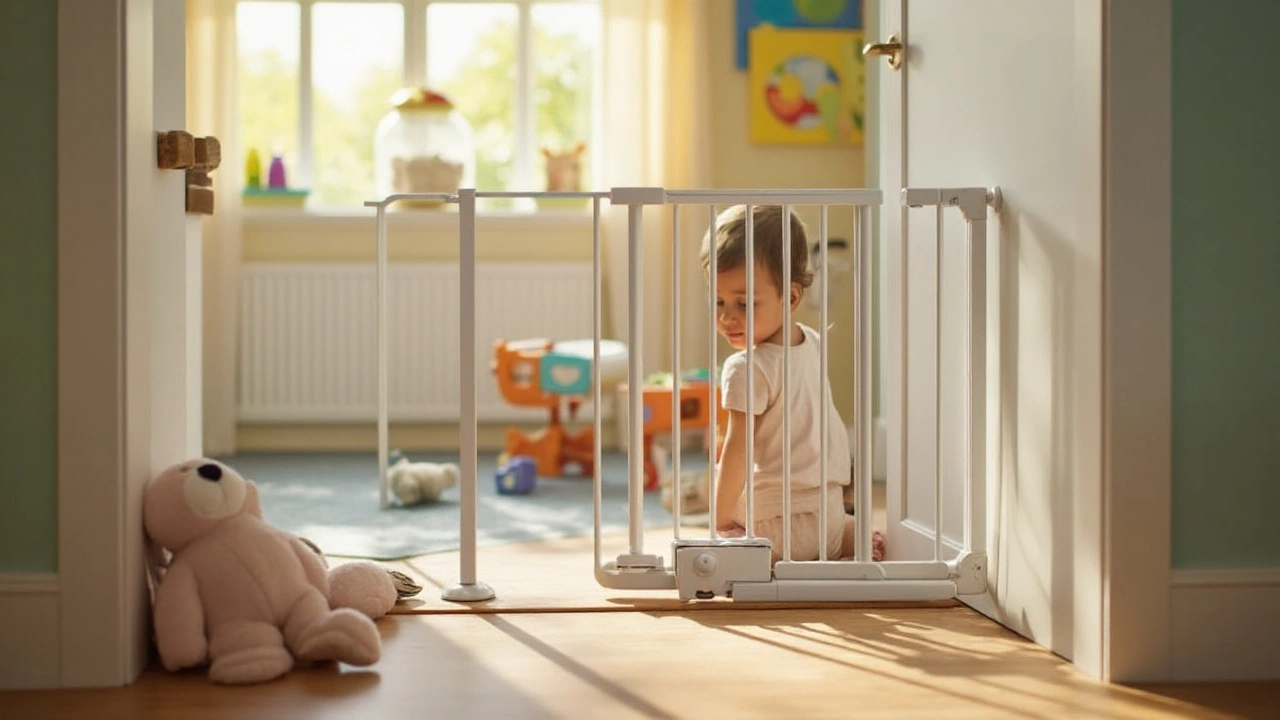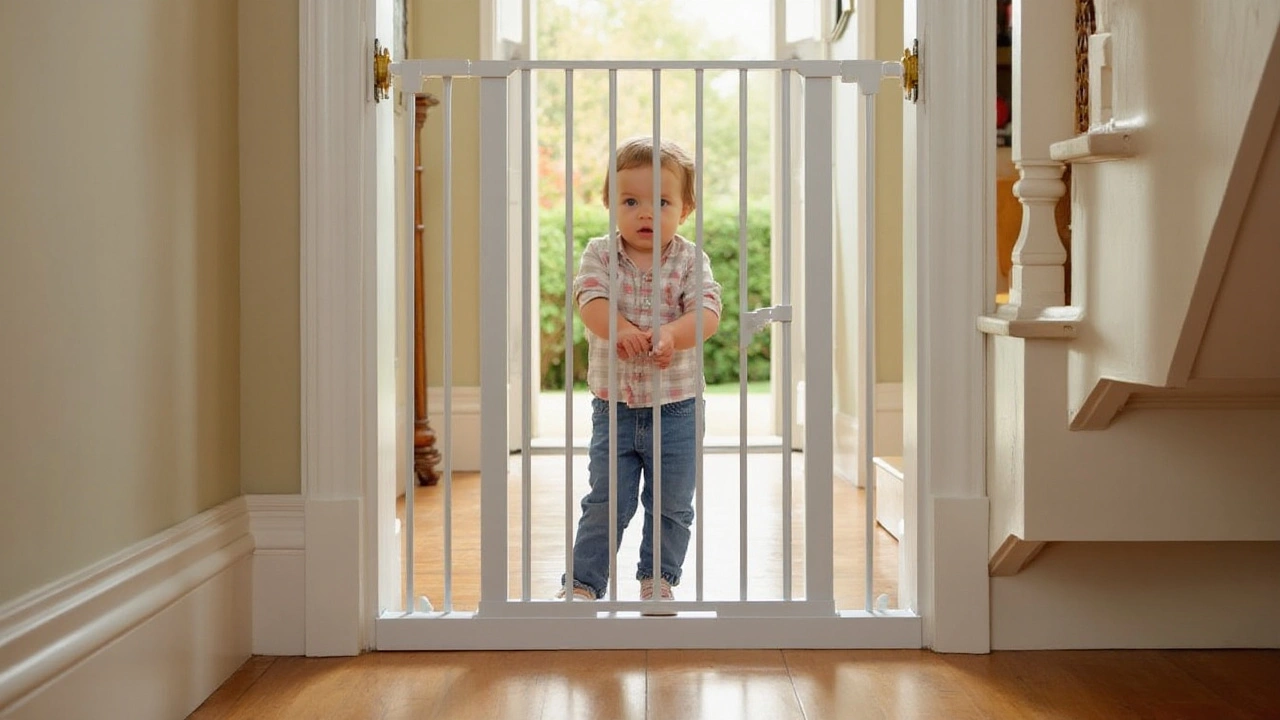Essential Guide to Toddler Door Gates: Ensuring Safety and Peace of Mind

As toddlers begin to explore the world around them, every corner of your home becomes a potential adventure site. This newfound independence and curiosity, while exciting, also calls for increased vigilance from parents. One question that often arises is whether a gate should be installed on the toddler's door.
With a range of options and considerations to ponder, deciding on a door gate can seem daunting at first. However, many parents find this decision becomes a pivotal step in creating a safe haven for their child. From preventing nightly wanderings to shielding little ones from potential hazards, these gates can prove invaluable.
In this guide, we'll delve into the reasons parents choose to use toddler gates, explore the different types available, and provide practical advice on installation and safety. For those considering alternatives, we'll also touch on other methods to maintain your little one's safety while ensuring they still enjoy their freedom to explore. Embrace this journey to peace of mind by understanding what best suits your family's needs.
- Why Consider a Toddler Gate?
- Types of Toddler Gates
- Installation Tips
- Safety Considerations
- Alternatives to Gates
Why Consider a Toddler Gate?
When toddlers reach the age of boundless energy and insatiable curiosity, every household surface and object becomes a playground. It's a time of giggles and discoveries, but it also ushers in new challenges for ensuring their safety. This is where the simple toddler gate shines as a hero in childproofing your home. Choosing to install a toddler door gate isn't just about setting physical boundaries—it's about creating a secure, worry-free environment for both the parents and the children. Consider how a toddler gate prevents nighttime adventures, when silent footsteps can venture where they shouldn't, like staircases or other risky areas. Residential resources highlight that one of the more frequent emergency visits among toddlers results from falls in the home. Using a well-placed gate helps minimize these statistics by blocking unsupervised access to dangerous zones.
Gates also serve as portable solutions for parents who need versatile options. Many gates are designed to be easily mounted and dismounted, allowing them to be relocated from one room to another as needed. This adaptability ensures consistent safeguarding without permanent alterations to the home's aesthetic. It's especially comforting for families who rent and cannot afford structural modifications. Dr. Sally Fox, a well-known pediatric safety expert, asserts that "
The flexibility of gates allows parents to customize safety measures as needed, facilitating a more dynamic approach to childproofing in today’s versatile home environments."
Moreover, gates are essential tools in teaching boundaries and self-discipline for young children. They learn to understand where they can and cannot go, adding an educational layer to their everyday interactions. While it might seem trivial, this guided confinement aids in setting the stage for understanding rules and cooperation. In addition, dedicated play spaces delineated by gates help toddlers focus on their toys and games without distractions, fostering creativity and concentration. This makes the child safety gates not just a protective measure but also a developmental aid. An effective gate should be robust yet easy for adults to operate, blending into daily routines seamlessly while standing as a silent sentry to protect little adventurers as they embark on their explorations.
Recent surveys indicate that homes with secured toddler areas see a significant decrease in household accidents among young children. This insight empowers parents to take strategic steps towards enhanced safety, aligning with their natural instincts to nurture and shield their little ones. Let's consider some compelling statistics in the form of a table to underline the importance of toddler gates:
| Hazard | Accident Reduction After Gate Installation |
|---|---|
| Stair Falls | 60% |
| Room Boundaries | 55% |
| Access to Hazardous Items | 70% |
Whether it’s preventing those midnight hallway strolls or blocking entry to the kitchen during dinner prep time, toddler gates are trusted allies in maintaining safety. As we tailor our homes to better suit the vibrant energies of our children, we also embrace these cleverly simple inventions for the peace and protection they bring into our lives.
Types of Toddler Gates
When it comes to selecting the perfect gate for your toddler, the variety available might seem a bit overwhelming initially. But worry not, each type of toddler door gate is designed with specific needs in mind. Understanding these can help you choose the best match for your household dynamic. Let's dive into the most common types.
Pressure-Fit Gates
Pressure-fit gates are quite popular among parents for their ease of installation. These gates use a system that relies on tension, meaning they don’t require drilling holes into walls or door frames. This can be an attractive choice if you’re renting or prefer a non-permanent solution. You simply adjust the gate until it fits snugly between the walls or door frames. However, while practical, pressure-fit designs may not be suitable for the top of stairs. According to child-proofing expert, Claire Lerner,
“Pressure-fit gates can slip under significant force, so it’s crucial they are used in safer areas, such as doorways.”
Wall Mounted Gates
Wall mounted gates offer a more secure option, as they are fixed with bolts and hinges into the wall. This makes them a suitable choice for areas requiring a higher level of safety, like at the top of stairs. While installation is more labor-intensive, the added security might be worth the effort. These gates often feature a swing open design, making it easy for adults to pass through. Despite the enhanced security, some may hesitate at installing these due to the need for permanent fittings, as this will leave marks on your walls when you eventually remove them.
Auto-Close Gates
If you are prone to forgetting to close the gate, an auto-close gate might be your best friend. These gates are designed to automatically swing shut and latch, offering convenience and added peace of mind. This feature is particularly beneficial in high-traffic areas of the home where the gate is frequently opened. The downside? These gates often come at a slightly higher price point, but for many, the convenience they offer can justify the expense.
Retractable Gates
Retractable gates are an innovative solution, offering flexibility in space usage. They work much like a roller blind, pulling out to cover a doorway or staircase and retracting when not in use. They’re ideal for spaces where traditional gates wouldn’t be practical. While aesthetically pleasing and space-saving, they may not offer the same level of hard barrier protection as other gates, but they are great for a more discreet safety measure.
Custom Gates
For those unique spaces where standard gates won’t fit, custom gates can be made to measure. These are perfect for irregular shaped spaces or wider openings like French doors. Although investing in a custom solution can be more costly, it ensures every corner is safely guarded.
| Type | Suitable For | Installation Difficulty |
|---|---|---|
| Pressure-Fit | Doorways | Easy |
| Wall Mounted | Top of Stairs | Moderate |
| Auto-Close | High-Traffic Areas | Easy |
| Retractable | Flexible Spaces | Easy to Moderate |
| Custom | Irregular or Large Spaces | Varies |
In deciding which gate is best, consider your unique needs and layout. Whether you desire a temporary, easy-to-remove solution, or a more permanent secure fixture, there's a child safety gate to match your requirement. You ensure not only the safety of your little explorer but also convenience and utility in your everyday life.

Installation Tips
Installing a toddler door gate might appear straightforward, yet doing it correctly is crucial for ensuring the safety and security of your child. The first step in the installation process is choosing the right spot. Ideally, the gate should be set up at the entrance of rooms or areas where you don’t want your toddler wandering unsupervised. For utmost security, particularly at the top of stairs, it's important to use hardware-mounted gates rather than pressure-mounted ones, as these offer more stability and are less likely to be dislodged by a curious toddler pushing against them.
The height of the gate is another essential consideration. The installed gate should be tall enough that your toddler cannot climb over it, generally recommended to be at least three-quarters of your child's height. Measuring the doorway or area where the gate will be placed is also vital to ensure a proper fit. Many gates come with extensions to accommodate wider spaces, so check the product specifications when purchasing. Proper fit prevents gaps where your child might squeeze through or get stuck. To secure the gate tightly, follow the manufacturer's instructions to the letter, which usually involves marking drill points and ensuring the gate is level during installation.
Tools you might need typically include a drill, screwdriver, and potentially a stud finder, especially if you're installing into drywall or plaster. A gate installed into a stud will be considerably more secure than one fixed into a hollow wall space. Even though it might be tempting to take shortcuts, never improvise with the provided installation kit; it's been designed, tested, and proven effective for the safety of your little one.
According to a child safety expert at Safe Kids Worldwide, "Proper installation of safety gates is key to preventing falls, especially on stairs. Choose gates without bars that toddlers can scale like a ladder."It's intriguing yet alarming to know that an improperly installed gate might increase rather than decrease risk. Hence, it pays to be meticulous in your approach. For those who aren't particularly handy, professional installation is an option worth considering to guarantee the task is done correctly. Additionally, always perform a safety check every few months to tighten screws and ensure the gate hasn’t loosened over time.
For an easy-to-follow summary, here's a quick checklist:
- Choose the appropriate gate type (hardware vs. pressure-mounted).
- Measure the installation area for correct sizing.
- Follow the manufacturer's instructions meticulously.
- Use the correct tools for a secure installation.
- Consider professional installation for staircases.
- Regularly check the gate for wear and tear.
Remember, the choices you make regarding the installation can make all the difference in creating a safe environment for your child as they begin to discover the exciting world beyond their initial confines. Every step you take in ensuring the secure setup of your toddler door gate is a stride towards peace of mind and the protective care your child needs as they grow and explore.
Safety Considerations
When it comes to ensuring the safety of your toddler, the implementation of a toddler door gate is not just a precaution, but a proactive step towards safeguarding their explorative nature. The early years are marked by rapid development and a boundless curiosity, which means hazards may lurk in unexpected places. Choosing the right gate goes beyond aesthetics; it’s essential to prioritize its efficiency in providing a robust barrier while still being easy for adults to operate. To start, always ensure that the gate is securely anchored. A well-installed gate can prevent accidental toppling, which can occur when a child decides to test their climbing abilities. A hardware-mounted gate offers superior stability compared to pressure-mounted ones, especially for stairs.
Material choice is also vital. Metals and sturdy plastics can generally withstand more force and are less likely to be damaged by persistent little hands or pets. Additionally, it’s important to consider the spacing between bars. Spaces should be narrow enough to prevent a toddler from slipping through or getting their head stuck. According to recommendations from the Juvenile Products Manufacturers Association, vertical slats should ideally be no more than 3 inches apart. This small detail could make a significant difference in preventing accident-related injuries.
Tested and Certified
Another critical factor is certification and compliance with safety standards. Products should adhere to established child safety standards, such as those set by the American Society for Testing and Materials (ASTM) or the Consumer Product Safety Commission (CPSC). Engaging in some research to confirm that your chosen gate has been tested and certified is time well spent. Look for certifications that verify its ability to withstand mechanical endurance tests.
"A certified gate acts as a silent sentry, standing ever-ready against your toddler's unrelenting curiosity," says child safety expert Dr. Lisa Moretti.This reassurance of quality can provide peace of mind.
Understanding the mechanism is the next step. Some gates feature a dual locking system that requires two steps to open, which may be too complex for a toddler but straightforward for caregivers. Others offer auto-closing hinges, adding an extra layer of security by ensuring the gate never remains unintentionally open. It’s beneficial to also consider the height of the gate. Ideally, a toddler gate should be at least three-quarters the height of the child to discourage climbing, which is around 22 inches for the average two-year-old. It should rise tall enough to deter most escape attempts yet not so tall as to inconvenience caregivers.
Routine Checks and Maintenance
Regular inspection and maintenance are just as pivotal as the initial installation. Over time, wear and tear can occur, especially in high-traffic areas or with frequent use. Keep an eye on bolts, latches, and the gate's alignment, ensuring everything remains tight and functional. In environments where the gate is exposed to weather changes, such as drafts or humidity, materials can warp, impacting efficacy and safety. Establishing a routine check, perhaps monthly, helps catch potential issues before they lead to mishaps. Always replace parts with those recommended by the manufacturer to maintain the integrity of the gate’s design.
Ultimately, the goal is to integrate the gate seamlessly into your home while maintaining a conscientious focus on safety. A well-chosen, properly installed, and consistently monitored toddler gate doesn’t just offer a barrier; it provides a controlled environment where your child can explore safely, allowing you to breathe a little easier amidst the delightful chaos that is early childhood.

Alternatives to Gates
When considering childproofing solutions, many parents often seek alternatives to the classic toddler door gate for a variety of reasons, ranging from aesthetic preferences to functional needs. One popular option is the use of door knob covers that prevent little hands from opening doors to potentially unsafe areas. These covers are designed to spin freely if turned incorrectly, thus foiling a toddler's attempts to gain access. This simple yet effective tool allows parents to retain the original look of their home while enhancing safety significantly.
Another viable alternative is installing a high-mounted latch on doors. By placing the latch out of your toddler's reach, you not only maintain a safe environment without altering door aesthetics but also ensure your peace of mind. A more technologically advanced solution involves using smart locks, which can be controlled via smartphone apps, allowing parents to secure doors remotely and monitor accessibility. This tech-savvy approach also provides the added benefit of integrating with other smart home devices for an all-encompassing security system.
Room dividers or play panels offer an innovative way to create safe play zones within larger living areas, effectively containing your child's exploration to a designated space without necessitating a physical barrier at a door. These panels are often modular and can be adjusted as your toddler grows and their playtime needs evolve. They can be particularly useful in open-plan homes where keeping specific areas off-limits is challenging.
For those inclined towards training and behavior modification, consistent routines can gradually teach toddlers boundaries without the need for physical barriers. This approach requires patience and persistence but can be rewarding, as toddlers learn to associate certain rooms or areas with specific activities, reducing their urge to wander. Combining verbal cues with gentle reinforcement methods can guide them towards understanding and respecting boundaries.
It is noteworthy that some parents utilize furniture arrangements strategically to block off certain sections of the house. By repositioning couches, tables, or larger decor items as makeshift barriers, you can prevent your toddler from accessing restricted zones, although this method may not be foolproof against a determined child.
A pivotal consideration with any alternative is ensuring consistency in their application and reliability. Child safety remains the priority and selecting solutions that suit your home layout and parenting style is crucial. As Dr. Sarah Johnson, a pediatric safety expert, often says,
“The key is balancing freedom with safety, creating an environment that encourages exploration while safeguarding against risk.”

